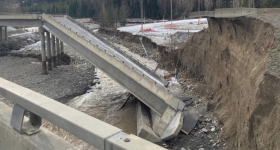tmalik3156
Structural
- Jun 21, 2021
- 104
Good day all.
Owner is afraid that flood will wash away the embankment, and the stub (perched) abutment will collapse. Abutment is on spread footing with no piles underneath. This has happened to some other bridges (a random example shown below).

So, we are doing a preliminary conceptual retrofit design.
We have heard about the following strategy:
1. Drill piles adjacent to the abutment (both sides)
2. Construct a cap on the piles
3. ''Connect'' the existing abutment with this new cap, as if the abutment has now ''extended'' and is being supported on piles at the ends.
Has anyone done similar design? How does the ''Connect'' work? Using large number of dowels? When the soil underneath the existing abutment fails, the existing abutment will behave like a beam, supported only at the newly extended ends. What can be done to efficiently transfer the moment and shear to the newly installed piles?
Alternately, we can squeeze in I-beams transversely under the girders and support that I-beam on the new piles.
Any suggestions?
Owner is afraid that flood will wash away the embankment, and the stub (perched) abutment will collapse. Abutment is on spread footing with no piles underneath. This has happened to some other bridges (a random example shown below).

So, we are doing a preliminary conceptual retrofit design.
We have heard about the following strategy:
1. Drill piles adjacent to the abutment (both sides)
2. Construct a cap on the piles
3. ''Connect'' the existing abutment with this new cap, as if the abutment has now ''extended'' and is being supported on piles at the ends.
Has anyone done similar design? How does the ''Connect'' work? Using large number of dowels? When the soil underneath the existing abutment fails, the existing abutment will behave like a beam, supported only at the newly extended ends. What can be done to efficiently transfer the moment and shear to the newly installed piles?
Alternately, we can squeeze in I-beams transversely under the girders and support that I-beam on the new piles.
Any suggestions?
